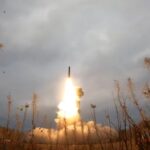
A snapshot of recent news from sources around the world on the ongoing Russia-Ukraine war.

Political Developments
Turkish President Recep Tayyip Erdogan’s peace proposal for the Russia-Ukraine war is “unacceptable,” Kremlin spokesman Dmitry Peskov said on Monday. Erdogan’s initiative would see the conflict frozen along the current lines, along with the creation of a demilitarized zone. Kyiv would be barred from joining NATO for 10 years under the proposal.
To meet the needs of the Russian military, North Korea is boosting the production of unmanned air vehicles (UAVs), including attack drones. Russia may be providing technology to Pyongyang to assist this effort, as well as other North Korean defense programs.
Estonia has expressed interest in procuring Ukrainian-made weapons, which could provide a source of income for Ukraine to continue its domestic production efforts. Ukraine currently bans military exports, and all equipment produced domestically goes to the Ukrainian Armed Forces.
Military Assistance to Ukraine
The British-built Storm Shadow missiles delivered to Ukraine may be available for use against targets in Russia. The U.S. provides electronic components for the Storm Shadow and it withheld permission for its technology to be used against targets inside Russia.
Germany plans to deliver 4,000 loitering munition drones to Ukraine starting next month, BILD reported. Batches will include several hundred each month, according to the report. The drones reportedly incorporate terrain analysis to enable them to continue onto targets even in cases of electronic warfare jamming communication with the operator.
Germany is also funding an agreement for Finnish satellite operator ICEYE and German arms manufacturer Rheinmetall to provide Ukraine with synthetic aperture radar imagery.
The U.S. announced a $275 million security assistance package for Ukraine that includes munitions for rocket systems and artillery and anti-tank weapons. The U.S. will also begin sending anti-personnel landmines to Ukraine, reflecting a policy shift. The mines are “non-persistent,” meaning they become inert after a certain amount of time.
Denmark is donating EUR130 million ($138 million) to help fund Ukraine’s defense industry, Prime Minister Mette Frederiksen announced on Tuesday. “Our support is long-term,” Frederiksen said.
Battlefield Updates
For the first time, the Ukrainian military fired ATACMS (Army Tactical Missile System) into Russian territory. This attack comes after the Biden administration lifted restrictions on the use of these missiles against targets inside Russia. The Wall Street Journal reported on Thursday that recent Ukrainian strikes in Kursk wounded a senior North Korean general.
Following the ATACMS strike, Russia initiated a missile strike on Dnipro, Ukraine, employing a newly developed intermediate-range ballistic missile (IRBM). Initially misclassified as an intercontinental ballistic missile (ICBM), the experimental IRBM was adapted from the Russian RS-26 Rubezh missile system. In a statement following the strike, Russian President Vladimir Putin called the missile ‘Oreshnik’ and said the strike was carried out in response to Ukraine’s ATACMS strikes.
“In combat conditions, one of the newest Russian medium-range missile systems was also tested. In this case, with a ballistic missile in non-nuclear hypersonic equipment. Our missilemen called it ‘Oreshnik.’ The tests were successful. The launch goal was achieved,” Russian President Vladimir Putin said.
U.S. officials called it an “experimental intermediate-range ballistic missile against Ukraine,” which has characteristics of an inter-continental ballistic missile but did not carry a nuclear warhead.
The Pentagon doesn’t foresee a Russian nuclear response to the recent ATACMS strike inside Russia. Moscow previously adjusted its nuclear doctrine in September by saying it would consider a nuclear retaliation against conventional attacks from a nuclear power.
Russia launched an attack on Ukraine’s energy infrastructure early in the week in what officials said was one of the largest attacks in recent months. A residential building was also hit, killing several people.
Originally published This Week in the Russia-Ukraine War (November 22) on by https://dsm.forecastinternational.com/2024/11/22/this-week-in-the-russia-ukraine-war-november-22/?utm_source=rss&utm_medium=rss&utm_campaign=this-week-in-the-russia-ukraine-war-november-22&utm_source=rss&utm_medium=rss&utm_campaign=this-week-in-the-russia-ukraine-war-november-22 at Defense & Security Monitor
Originally published Defense & Security Monitor

